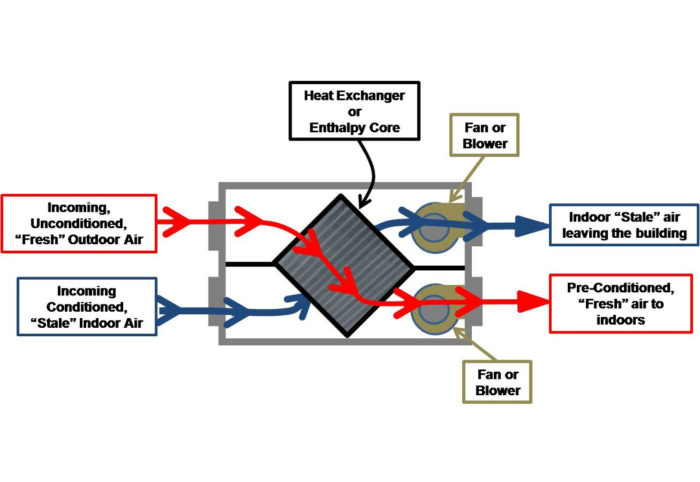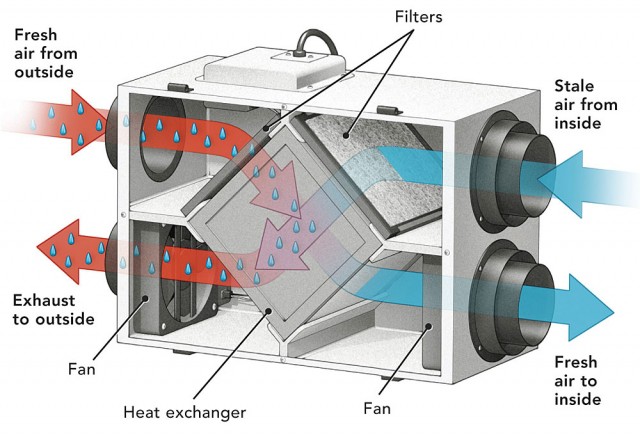Common Mistakes About HRV That Homeowners Should Avoid
Just How Heat Recovery Ventilation Enhances Indoor Air Quality and Reduces Power Expenses
Heat Recovery Ventilation (HRV) systems play a necessary function in boosting interior air quality while simultaneously reducing energy expenses. By successfully trading stale indoor air with fresh exterior air, HRVs help keep excellent moisture and reduce contaminants. In addition, their ability to recoup warm from outgoing air decreases the stress on home heating and cooling systems. As energy prices remain to rise, comprehending the full possibility of HRV systems becomes progressively essential for home owners and services alike.
Comprehending Heat Recovery Ventilation Solutions

Heat recovery ventilation (HRV) systems play an essential role in enhancing interior air high quality, particularly in contemporary, energy-efficient buildings. These systems are created to transfer heat from the outgoing stale air to the inbound fresh air, therefore decreasing power loss while maintaining optimal temperature level levels inside. HRVs contain a warm exchanger, followers, and ductwork, helping with the constant blood circulation of air. By getting rid of interior contaminants and presenting fresh air, HRVs aid to balance moisture degrees, protect against mold and mildew development, and decrease allergens. The efficiency of HRV systems depends on their capability to recoup as much as 80% of the warmth from the worn down air, advertising energy conservation while ensuring a healthy and balanced interior atmosphere. Their combination is essential in achieving sustainable living practices.
The Importance of Indoor Air Quality
Indoor air quality (IAQ) is a crucial aspect affecting the health and wellness of occupants in any atmosphere. Poor IAQ can lead to various health and wellness problems, consisting of respiratory troubles, allergies, and tiredness. Furthermore, it can aggravate status quo such as bronchial asthma. Factors adding to low IAQ include toxins from indoor sources like cleaning agents, mold and mildew, and insufficient air flow. Subsequently, keeping great IAQ is essential for advertising a secure and comfortable living or functioning space. Efficient methods to enhance IAQ entail regular monitoring of air high quality, correct air flow systems, and minimizing making use of dangerous materials inside your home. By focusing on IAQ, people can guarantee a much healthier setting that fosters efficiency and total quality of life.
Power Effectiveness Benefits of HRV Systems
Lots of property owners and structure supervisors are significantly acknowledging the energy performance benefits of warm healing ventilation (HRV) systems. By moving warmth from worn down indoor air to incoming fresh air, HRV systems markedly minimize the energy needed for home heating and cooling. This process minimizes reliance on conventional HVAC systems, resulting in reduced power bills. Furthermore, HRVs help keep a balanced indoor environment, avoiding extreme home heating or cooling needs. The capacity to recuperate up to 90% of the heat from outgoing air also supports sustainability efforts by decreasing total power consumption. As a result, HRV systems add not just to set you back financial savings yet additionally to a decreased carbon impact, aligning with the expanding focus on energy-efficient building techniques.
Installment and Upkeep Considerations
The effective implementation of warmth healing ventilation (HRV) systems needs mindful factor to consider of installation and upkeep variables to ensure peak efficiency. Correct positioning of the HRV device is crucial, as it ought to be installed in an area that makes the most of air movement while reducing noise disturbance. In addition, ductwork should be suitably sized and protected to stop power loss. Routine maintenance, consisting of filter substitute and system cleaning, is vital to protect optimal capability and indoor air top quality. Proprietors ought to establish a routine upkeep routine to recognize and address potential problems before they rise. Cooperation with seasoned experts HRV Heat Recovery Ventilation throughout both installment and upkeep stages can improve the durability and effectiveness of HRV systems, eventually resulting in much better interior environments and decreased energy expenses.
Real-World Applications and Success Stories
Checking out real-world applications of heat healing ventilation (HRV) systems exposes their significant effect on indoor air top quality and energy performance across numerous settings. In property structures, property owners have reported better air top quality, leading to less allergic reactions and breathing concerns. Schools implementing HRV systems have noted enhanced student focus and lowered absenteeism because of better air flow. Industrial buildings, such as offices and retail areas, have actually experienced lower power costs and raised employee productivity. A company office in a pleasant climate achieved a 30% reduction in power costs after mounting an HRV system. These success tales show that HRV innovation not only contributes to healthier settings but additionally supplies tangible financial benefits, making it an important investment for different markets.
Often Asked Questions
Can HRV Equipments Reduce Irritants in Indoor Air?
The efficiency of HRV systems in decreasing interior irritants largely pivots on their capacity to filter and exchange air. HRV Heat Recovery Ventilation. By continually changing stale air, these systems can substantially reduce allergen levels throughout indoor atmospheres

How Does Moisture Affect HRV System Performance?
Humidity greatly influences HRV system efficiency; high levels can cause condensation, reducing performance, while low moisture might boost air exchange. Balancing moisture is vital for ideal procedure and maintaining indoor air high quality.
Are HRV Systems Noisy During Procedure?
HRV systems can produce varying noise degrees during procedure, relying on their style and installment. Some systems operate silently, while others may produce noticeable noise, specifically at greater air movement setups or when poorly preserved.
What Is the Typical Lifespan of an HRV System?

Can HRV Systems Be Utilized in All Environments?
HRV systems can be used in different climates, but their efficiency may differ - HRV Heat Recovery Ventilation. In severe temperature levels, adjustments or supplemental systems may be essential to ensure suitable efficiency and comfort while maintaining indoor air quality